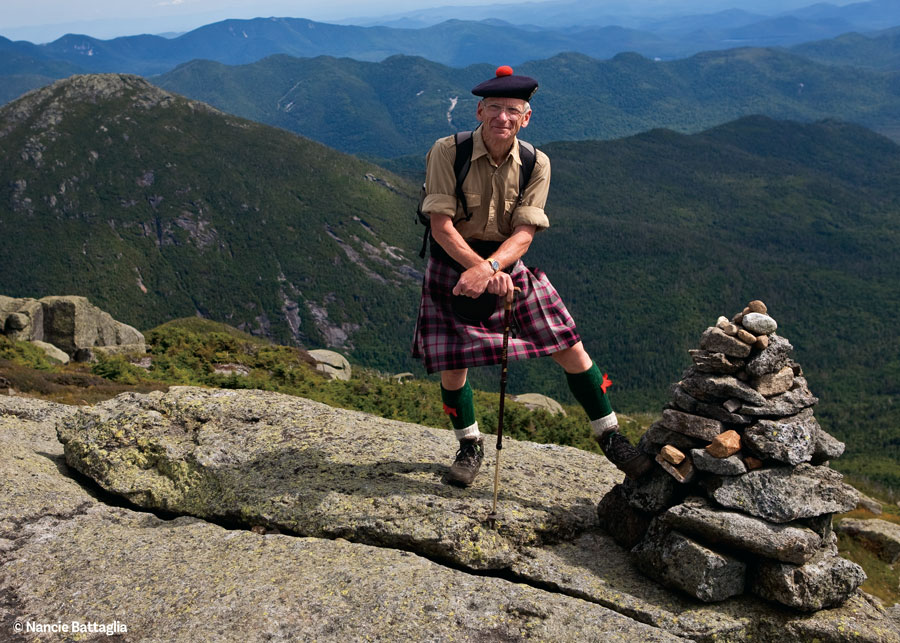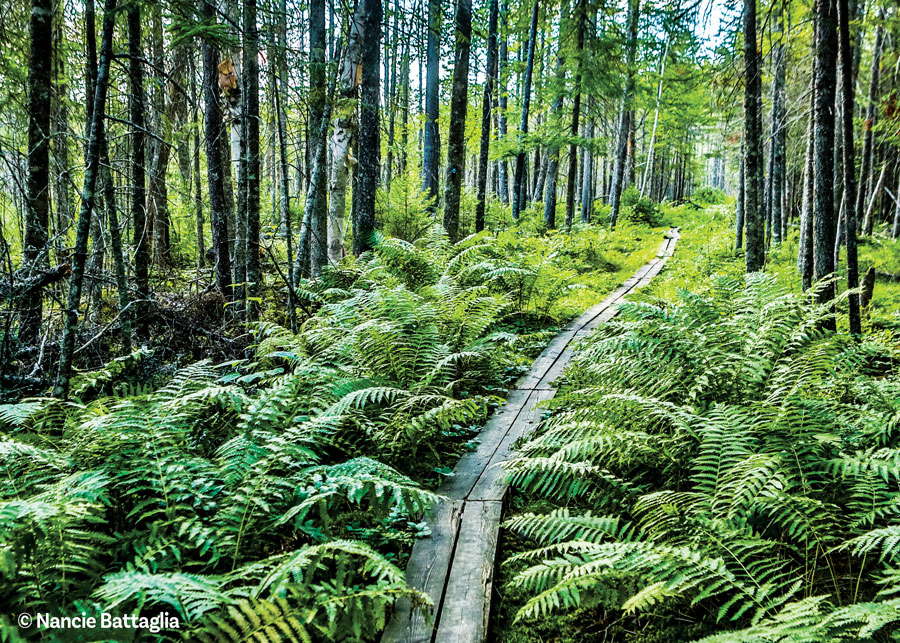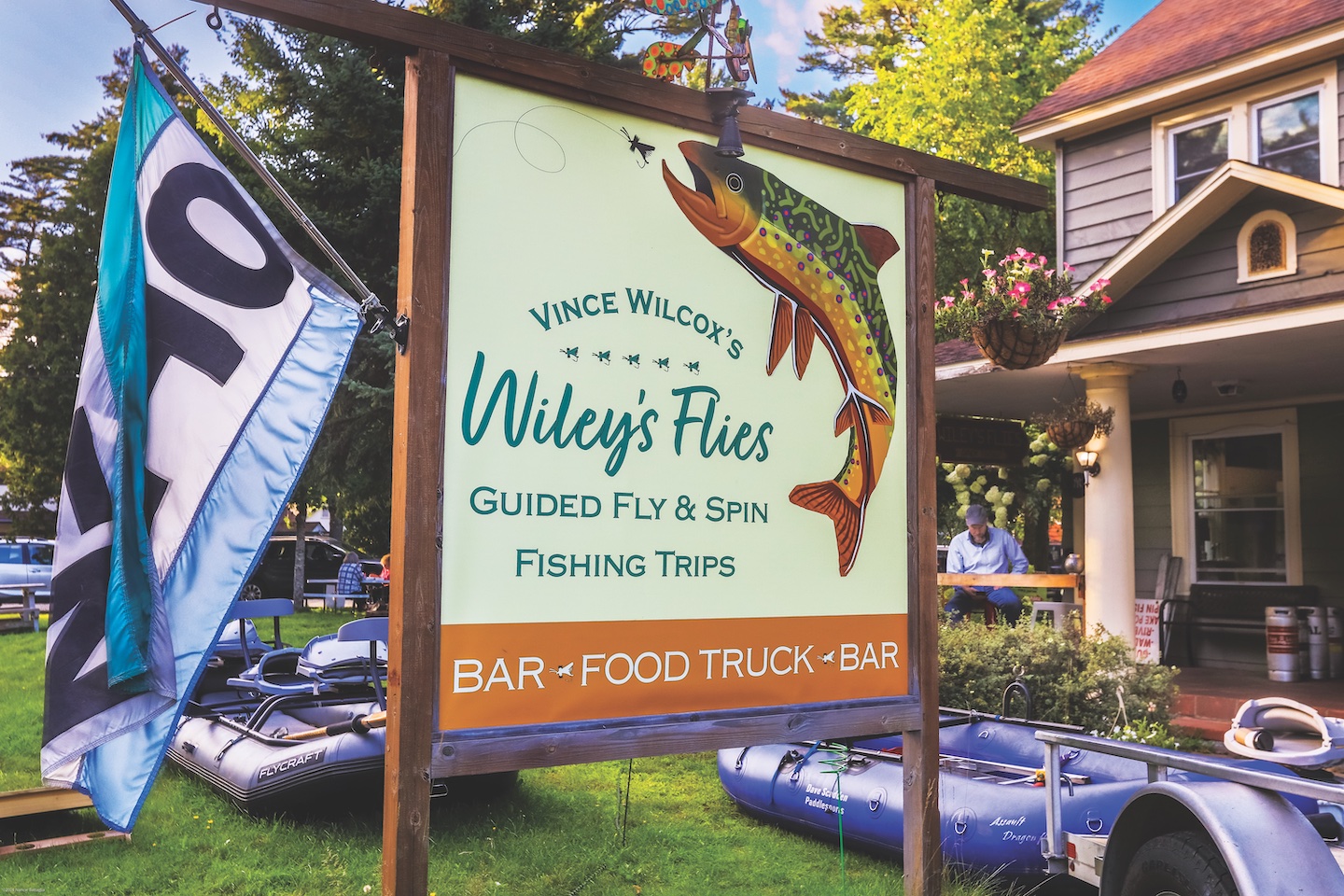Photograph by George Aman, courtesy of William “Jay” O’hern
June 1946. World War II has ended, the economy is rebounding, and life in America looks sunny.
In the Adirondacks, Troop 1 of the Boy Scouts of America from Paoli, Pennsylvania, is on its traditional 15-day canoe outing, mostly on what is today known as the “90-Miler” route, from Old Forge to Saranac Lake. On one of those days, the Scouts stow their canoes and hike the Northville-Placid Trail upstream along the Cold River. After 12 hot, buggy miles, split by a night at Seward lean-to, they arrive at the über-rustic compound of iconic hermit Noah John Rondeau, who, though known to be irascible, welcomes and “confabs” loquaciously with them.
It’s a moment the 16 awestruck boys, all certified or aspiring Eagle Scouts, will remember for the rest of their lives. One, Richard “Dick” Henderson, reminisced about it until days before his death in October 2023, at age 94. Rondeau “was a kindly grandfather, joking and jolly and asking questions,” he told his daughter, Alice Funk, in a video-recorded conversation shortly before his passing.
Even better, Henderson remembered that the troop had maintained a log of their expedition and, doggedly persistent by nature, succeeded in unearthing it. Written in tones of self-deprecating humor by participants George Aman, Bill McLear and Herbert “Hobey” Henderson—Dick’s brother—it vividly describes an encounter with the Adirondack backcountry that made a lifelong impression on a bunch of suburban kids.
What prompted the search for that old log? Funk explained, “My mother read William ‘Jay’ O’Hern’s book Noah John Rondeau’s Adirondack Wilderness Days: A Year with the Hermit of Cold River Flow so many times it was tattered. Five or six years ago, she read this passage from Noah’s quirky diary aloud to my dad: ‘Sunday, June 23rd, 1946 – Nicest Ever June Day. 16 men and boys come, go (Penn. Scouts).’”
“1946 … June 23rd … Sunday … that was us!” Henderson exclaimed. “We were those ‘Penn. Scouts’!” He set himself on a mission to find the log, which, after enlisting Aman, his brother and the new leaders of Paoli Troop 1, he did. Aman had “keyboarded” it on his father’s ancient manual typewriter with help from Hobey Henderson, who then constructed a wooden cover for it. The log languished for years in Henderson’s bureau drawer, moving from place to place with him, until he gave it back to the troop around 2011.
In describing the trip, the long-lost log reveals much about backcountry outings some 75 years ago. It contains lists of food and supplies, some to be purchased (steak, eggs, steel wool for reasons unstated, “surupe, maple”), the rest to be mailed to post offices en route (bacon, canned salmon, spaghetti).
No gorp and protein bars for these guys. They ate like royalty.
As designated Commissary Chief, Dick Henderson was given charge of the food list compiled by trip leader Bill Patterson, and tasked with getting the price of every item from the grocery store. He did so with his mother’s help. Others also had duties assigned: Bill McLear, First Aid; Peter Schultz, Fire Warden; John Holtzapple, Mail Orderly/Male Disorderly; Jeff Aronson, Absolutely Nothing. The log also features a generous sprinkling of humorously captioned photos, mostly courtesy of Aman and his new Kodak Brownie camera.
Paoli 1 convoyed by car to Old Forge on Saturday, June 15, 1946. The pre-Interstate drive, a six-hour trip today, took them nearly 11 hours plus one tire blowout. They “were met by a swarm of unfriendly insects,” set up camp near a boat livery, and walked into town for insect repellent and mosquito nets.
The next morning, “cold and misty,” some of the boys learned how difficult it could be to prepare all their gear for the space restrictions of canoeing while “several went to church,” this being 1946. By midday, logistical entanglements sorted, they set off, jamming into a lean-to on Third Lake the first night.
And so it went until the planned detour up the Cold River to meet Mr. Rondeau, mayor of Cold River City, population 1. The bug-bedeviled troop paddled and carried through the Fulton Chain, camped on Big Island in Raquette Lake, wrote letters home, and discovered why Long Lake is so named. They discovered the same about Cold River, especially Bob Ives, who fell in while cleaning his gear atop a boulder.
The boys paddled up the Cold River “until it became impassible,” camouflaged their vessels and unneeded gear in the forest, and took to the trail, which, accustomed to the manicured pathways they enjoyed at Valley Forge, they found rough. The morning after their steamy night at the Seward lean-to, they were prepared by Patterson, who had encountered Rondeau previously, for what—or what not—to expect from the unpredictable recluse.
They got the Good Hermit. According to the log, he showed them cards he’d received from previous visitors and pointed out remnants of old logging roads. He explained how wild flora and fauna commingled with his meager vegetable garden, and told them stories about bow-hunting and trapping and long-past lumbering days.
Rondeau happily partook of the carry-in lunch the Scouts brought. He showed them his hunting knife and his fiddle; its broken string spared the boys the pain of having to listen to it.
“Noah John led us on an explanatory tour of his ‘city,’” an abandoned lumber camp that he’d commandeered years earlier, Dick Henderson told Jay O’Hern, who had offered to publish the log. “I was not only fascinated by this unusual man, but also awed by his towering tepees made from long wooden poles—next winter’s firewood.
“He obviously loved to have visitors even though he was a hermit,” Henderson said, capturing half of the enigmatic Rondeau in one sentence. Not everyone would agree; some, game wardens in particular, were met by a short, stooped man pointing a rifle at them.
No rifles this time. In exchange for his hospitality, the boys gave Rondeau “tobacco, lard and coffee,” according to the log, “for which he was very grateful.” In return, Rondeau awarded each boy a partridge feather. He also wrote a message in their log: “Hear ye–Hear ye, Pennsylvania: Sixteen of Your Rough Neck Scouts called at my City and took everything They could hide in Their cameras. N. J. Rondeau, City Mayor.”
The hours passed, the forest’s shadows grew longer; soon it was time to part company. The boys left Rondeau at his city gate and carried permanent memories with them down the trail.
“When we were leaving, he told me, ‘Watch out for those pretty girls in Philadelphia!’” Dick Henderson said.
The rest of the trip may have been anticlimactic. The Scouts retrieved their canoes, camped at Raquette Falls, traversed the Indian Carry into the Saranac Lakes. They took out at Saranac Inn and dispersed, some to other adventures, some to their homes. College, careers and families were to come.
And what of the log? It’s in good hands at home in Paoli, but it’s also available as a book compiled by O’Hern, A Classic Adirondack Paddle (North Country Books, 2023). The volume contains much of the unaltered log and numerous pictures; it came out just two days after Dick Henderson died. In his dedication, O’Hern writes, “This project would never have materialized without his leadership.”

























